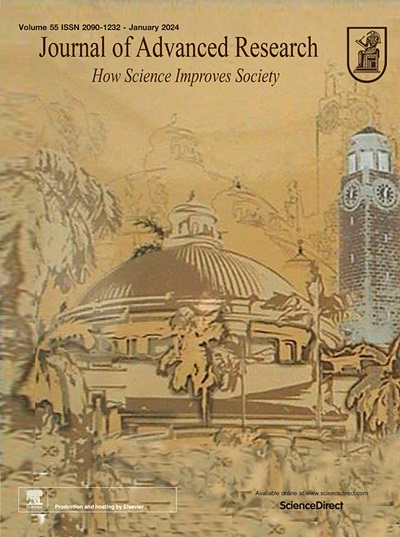谷胱甘肽杂化聚(β-氨基酯)-质粒纳米颗粒,用于增强基因传递和生物安全性。
IF 11.4
1区 综合性期刊
Q1 MULTIDISCIPLINARY SCIENCES
引用次数: 0
摘要
导言:CRISPR/Cas9 基因编辑技术极大地推动了基因治疗的发展,而基因载体则是其成功的关键因素之一。众所周知,聚(β-氨基酯)(PBAE)作为一种杰出的非病毒阳离子基因载体,会提高细胞内活性氧(ROS)水平,从而可能导致细胞毒性,进而影响基因转染效果(T.E.):开发一种简单而有效的策略,提高 PBAE 在体内和体外的基因传递能力和生物安全性:方法:我们使用谷胱甘肽(GSH)--一种能调节细胞内 ROS 水平的临床常用药物--制备了一种 PBAE-质粒纳米颗粒(NPs)混合体系。通过流式细胞术、RNA-seq、聚合酶链式反应(PCR)和桑格测序对该系统进行了体外表征,并通过成像、PCR、桑格测序和组织学分析评估了其在体内的安全性和有效性:结果:GSH-PBAE-质粒 NPs 的粒径为 168.31 nm,ζ电位为 15.21 mV。与不含 GSH 的 PBAE-质粒 NPs 相比,在不同细胞系中观察到的 T.E. 和基因编辑效率提高了 10 % 到 100 %。体外实验结果证明,与 PBAE 质粒 NPs 相比,GSH-PBAE 质粒 NPs 能将细胞内 ROS 水平降低 25%-40%,将上调/下调基因总数从 4,952 个减少到 789 个,并显著避免了与细胞氧化应激反应和细胞生长调节信号通路相关的基因表达紊乱。基因转染后,它们对细胞周期的影响也较小,溶血现象较轻,细胞存活率较高。此外,GSH 杂交 PBAE 质粒 NPs 通过提供 CRISPR/Cas9 基因编辑系统,靶向裂解 EBV 相关癌基因并下调其表达水平,在 Epstein-Barr 病毒(EBV)感染的小鼠肿瘤模型中表现出更高的安全性和肿瘤抑制能力。这一简单而有效的策略有望促进非病毒载体基因递送的临床应用。本文章由计算机程序翻译,如有差异,请以英文原文为准。

Glutathione hybrid poly (beta-amino ester)-plasmid nanoparticles for enhancing gene delivery and biosafety
Introduction
CRISPR/Cas9 gene editing technology has significantly advanced gene therapy, with gene vectors being one of the key factors for its success. Poly (beta-amino ester) (PBAE), a distinguished non-viral cationic gene vector, is known to elevate intracellular reactive oxygen species (ROS) levels, which may cause cytotoxicity and, consequently, impact gene transfection efficacy (T.E.).
Objectives
To develop a simple but efficient strategy to improve the gene delivery ability and biosafety of PBAE both in vivo and in vitro.
Methods
We used glutathione (GSH), a clinically utilized drug with capability to modulating intracellular ROS level, to prepare a hybrid system with PBAE-plasmid nanoparticles (NPs). This system was characterized by flow cytometry, RNA-seq, Polymerase Chain Reaction (PCR) and Sanger sequencing in vitro, and its safety and efficacy in vivo was evaluated by imaging, PCR, Sanger sequencing and histology analysis.
Results
The particle size of GSH-PBAE-plasmid NPs were 168.31 nm with a ζ-potential of 15.21 mV. An enhancement in T.E. and gene editing efficiency, ranging from 10 % to 100 %, was observed compared to GSH-free PBAE-plasmid NPs in various cell lines. In vitro results proved that GSH-PBAE-plasmid NPs reduced intracellular ROS levels by 25 %–40 %, decreased the total number of upregulated/downregulated genes from 4,952 to 789, and significantly avoided the disturbance in gene expression related to cellular oxidative stress-response and cell growth regulation signaling pathway compared to PBAE-plasmid NPs. They also demonstrated lower impact on the cell cycle, slighter hemolysis, and higher cell viability after gene transfection. Furthermore, GSH hybrid PBAE-plasmid NPs exhibited superior safety and improved tumor suppression ability in an Epstein–Barr virus (EBV)-infected murine tumor model, via targeting cleavage the EBV related oncogene by delivering CRISPR/Cas9 gene editing system and down-regulating the expression levels. This simple but effective strategy is expected to promote clinical applications of non-viral vector gene delivery.
求助全文
通过发布文献求助,成功后即可免费获取论文全文。
去求助
来源期刊

Journal of Advanced Research
Multidisciplinary-Multidisciplinary
CiteScore
21.60
自引率
0.90%
发文量
280
审稿时长
12 weeks
期刊介绍:
Journal of Advanced Research (J. Adv. Res.) is an applied/natural sciences, peer-reviewed journal that focuses on interdisciplinary research. The journal aims to contribute to applied research and knowledge worldwide through the publication of original and high-quality research articles in the fields of Medicine, Pharmaceutical Sciences, Dentistry, Physical Therapy, Veterinary Medicine, and Basic and Biological Sciences.
The following abstracting and indexing services cover the Journal of Advanced Research: PubMed/Medline, Essential Science Indicators, Web of Science, Scopus, PubMed Central, PubMed, Science Citation Index Expanded, Directory of Open Access Journals (DOAJ), and INSPEC.
 求助内容:
求助内容: 应助结果提醒方式:
应助结果提醒方式:


